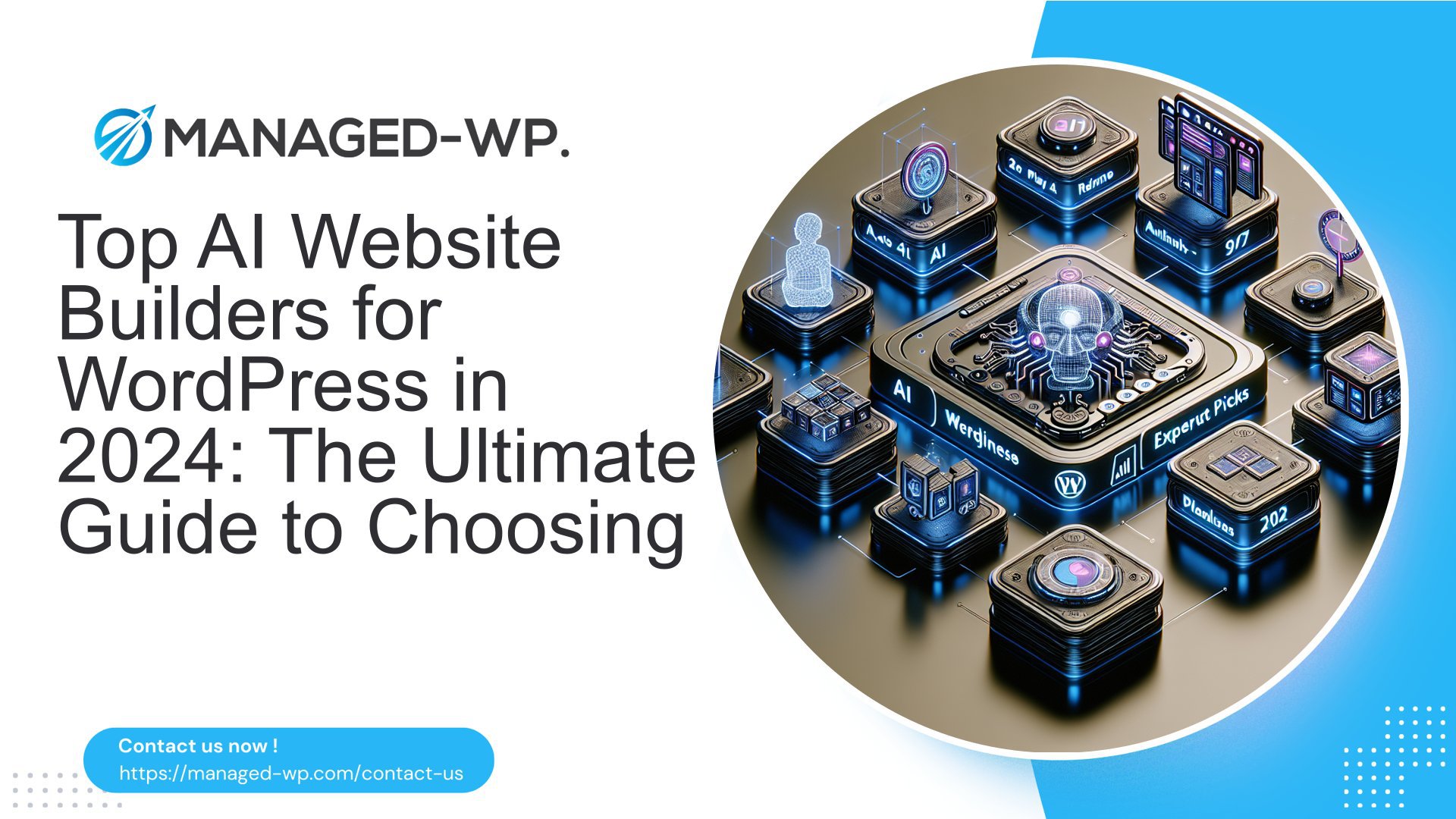WordPress 是一款功能强大且广泛使用的内容管理系统 (CMS),为全球数百万个网站提供支持。其用户友好的界面、广泛的插件生态系统和自定义选项使其成为个人和企业的首选平台。然而,与任何技术一样,WordPress 也存在一系列技术挑战,可能会阻碍网站的性能、维护和安全。
在本文中,我们将探讨 WordPress 用户面临的最常见的技术挑战,并深入探讨 WordPress 自动化的概念。我们将讨论自动化如何帮助克服这些挑战,确定 WordPress 自动化的基本工具,并提供最佳实践来优化您的 WordPress 体验。
因此,无论您是经验丰富的 WordPress 开发人员,还是希望利用自动化功能的初学者,本文都将为您提供所需的知识和工具,以应对技术挑战并简化您的 WordPress 工作流程。让我们开始吧!💪
了解 WordPress 中的技术挑战
WordPress 无疑是当今最流行的内容管理系统 (CMS) 之一。凭借其用户友好的界面和丰富的功能和插件,它已成为个人和企业创建和管理网站的首选平台。然而,与任何其他技术一样,WordPress 也面临着不少技术挑战。在本文中,我们将探讨用户在使用 WordPress 时遇到的一些常见问题,并提供如何克服这些问题的见解。
🛠️ 更新和维护问题
更新是任何软件系统的重要组成部分,WordPress 也不例外。定期更新有助于提高性能、修补安全漏洞并引入新功能。但是,更新 WordPress 有时可能是一把双刃剑。以下是与更新和维护相关的一些挑战:
- 兼容性问题:更新 WordPress 核心、主题和插件有时会导致兼容性问题。较旧的主题和插件可能与最新版本的 WordPress 不兼容,从而导致网站功能损坏和设计不一致。
- 插件冲突:WordPress 插件是扩展网站功能的强大工具。但是,使用过多插件或不兼容的插件通常会导致冲突。这些冲突可能会导致意外错误,在某些情况下甚至会导致整个网站瘫痪。
为了应对这些挑战,遵循更新和维护的最佳实践至关重要:
- 始终备份您的网站:在执行任何更新之前,建议对您的网站进行完整备份。这样,如果在更新过程中出现问题,您就可以恢复到以前的版本。
- 在开发环境中测试更新:在更新您的实时网站之前,建议在单独的暂存或开发环境中测试更新。这样,您就可以在兼容性或插件冲突影响您的实时网站之前识别并修复它们。
为了简化 WordPress 网站开发工作流程并自动执行更新,您可以使用以下工具 WordPress 网站开发工作流程,提供有效的解决方案来处理更新和维护任务。
内容管理中的复杂性
WordPress 的主要优势在于其内容管理功能。但是,随着网站的发展和需要管理的内容越来越多,您可能会开始面临一些挑战:
- 内容组织:随着帖子、页面和媒体文件数量的增加,有效地组织内容变得至关重要。如果没有适当的组织,查找和管理内容可能会成为一项艰巨的任务。
- 编辑器限制:虽然默认的 WordPress 编辑器适合基本内容创建,但它可能缺乏复杂布局、多媒体管理或自定义工作流程所需的高级功能。
为了克服这些内容管理挑战,请考虑以下提示:
- 使用类别和标签:利用类别和标签对内容进行分类和分组。这可让您和您的访客更轻松地浏览您的网站并找到相关信息。
- 利用自定义帖子类型和分类法:WordPress 允许您创建自定义帖子类型和分类法来管理不同类型的内容。此功能使您能够根据特定需求定制内容管理系统。
- 探索高级内容编辑器插件:WordPress 有各种内容编辑器插件,可提供高级特性和功能。这些插件可以帮助您创建复杂的布局、管理多媒体内容并改善整体内容创建体验。
🎨请继续关注下一部分,我们将讨论用户在使用 WordPress 时遇到的性能和安全问题。
WordPress 自动化的概念
在快速发展的 Web 开发领域,WordPress 自动化已成为行业变革者。它指的是通过使用自动化工具和工作流程来简化 WordPress 生态系统中的任务。通过利用自动化,开发人员和网站所有者可以节省时间和精力、提高生产力并消除人为错误的可能性。
🤔 但是 WordPress 自动化到底包含什么?让我们深入了解一些核心概念:
1.插件自动化
插件是任何 WordPress 网站必不可少的组件,可让用户扩展功能并添加特性。通过自动化,管理插件变得轻而易举。安装、更新和激活插件等任务可以自动化,从而腾出时间进行更关键的开发工作。
2.内容发布自动化
定期发布新鲜内容对于任何网站来说都至关重要,但这可能很耗时。WordPress Automation 有助于简化内容发布流程。从安排帖子到自动在社交媒体平台上分享帖子,自动化工具可以简化内容管理并提高网站的整体性能。
3.备份和安全自动化
对于任何在线平台来说,安全和备份都是至关重要的。WordPress Automation 提供了强大的解决方案,用于自动备份和增强安全措施。从定期备份到监控漏洞和恶意软件,自动化可以帮助保护您的网站并让您高枕无忧。
4.网站性能优化
网站加载缓慢会对用户体验和搜索引擎排名产生不利影响。WordPress Automation 可让您轻松优化网站性能。借助自动化工具,您可以自动执行缓存、图像压缩和代码最小化等任务,从而缩短页面加载时间并提高用户满意度。
5.分析和报告自动化
了解网站的表现对于做出明智的决策至关重要。自动化通过自动生成综合报告,使跟踪和分析网站分析变得更加容易。通过自动化分析和报告,您可以获得有关用户行为、流量来源、转化率等的宝贵见解。
通过采用 WordPress 自动化,您可以利用技术的力量来简化和精简您的 Web 开发流程。从插件管理到内容发布和性能优化,自动化提供了一系列优势,可以增强您的 WordPress 体验。
前往 WordPress 自动化概念 部分来探索有关这个令人兴奋的领域的更多信息,并了解自动化如何彻底改变您的 WordPress 之旅。🚀
WordPress 自动化如何应对技术挑战
在当今快节奏的数字环境中,企业和个人严重依赖他们的网站来传达信息和吸引客户。然而,管理 WordPress 网站可能是一项艰巨的任务,尤其是在面临技术挑战时。幸运的是,WordPress 自动化为这些障碍提供了解决方案,使网站所有者能够简化流程并专注于真正重要的事情 - 他们的内容和受众。
自动更新和维护
WordPress 自动化最显著的优势之一是它能够轻松处理更新和维护任务。使用传统的手动更新,网站所有者需要手动跟踪和安装新版本的 WordPress、插件和主题。这不仅浪费了宝贵的时间,而且还使网站容易受到安全风险的威胁。但是,有了自动更新,WordPress 可以为您处理这个繁琐的过程。它使您的网站保持最新版本,确保最佳性能并降低安全漏洞的风险。
高效的内容管理
内容是任何网站的命脉,有效管理内容是成功的关键。WordPress 自动化可以简化内容管理流程,帮助网站所有者节省时间和精力。内容安排、自动发布和内容组织工具等主要功能使用户能够无缝地规划、创建和分发其内容。无论是安排博客文章、创建登录页面还是管理多媒体内容,自动化都使网站所有者能够专注于创建引人入胜的内容,而不会被手动任务所困扰。
增强性能和安全性
在当今的数字时代,网站性能和安全性至关重要。借助专为 WordPress 设计的自动化工具和插件,网站所有者可以轻松优化网站的性能并增强安全性。这些工具可以识别和修复性能瓶颈、优化图像、启用缓存以及实施防火墙和监控系统等安全措施。通过自动执行这些任务,网站所有者可以确保其网站运行顺畅、加载迅速并免受恶意攻击。
易于集成和兼容
WordPress 的多功能性在于它能够与各种第三方服务和应用程序无缝集成。但是,手动集成这些服务可能是一个耗时的过程。WordPress 自动化通过提供插件和工具简化了集成和兼容性过程,这些插件和工具有助于轻松与电子邮件营销平台、客户关系管理 (CRM) 系统和社交媒体网络等热门服务集成。借助自动化,网站所有者可以将他们的 WordPress 网站连接到他们喜欢的工具和服务,而无需大量编码或技术专业知识。
总之,WordPress 自动化通过提供自动更新和维护、高效的内容管理、增强的性能和安全性以及易于集成和兼容性来解决与网站管理相关的技术挑战。这些优势使网站所有者可以专注于创建出色的内容并与受众互动,同时将技术方面交给 WordPress 自动化工具。因此,无论您是企业主、博主还是有抱负的企业家,都可以拥抱 WordPress 自动化的强大功能并释放您网站的全部潜力。🚀
WordPress 自动化工具
介绍:
在 WordPress 世界中,自动化是维护无缝高效网站的关键。从定期更新和内容管理到性能优化和安全,有各种工具和插件可用于自动化这些流程。在本文中,我们将探讨一些 WordPress 自动化的基本工具,这些工具可以节省您的时间和精力,让您专注于最重要的事情 - 创建精彩内容并扩大您的在线影响力。
定期更新和维护的插件
保持 WordPress 网站最新状态对于其性能、安全性和整体用户体验至关重要。幸运的是,有插件可以自动执行这些更新和维护任务。以下是一些值得考虑的插件:
- 简易更新管理器: 该插件允许您自动执行核心、插件和主题更新,确保您的网站始终运行最新版本,无需人工干预。
- WP 扫描: 随着时间的推移,您的数据库会积累不必要的数据,从而影响您网站的性能。WP Sweep 可自动清理数据库,从而优化其效率。
- 备份伙伴: 定期备份是保护网站数据的必要措施。BackupBuddy 允许您安排自动备份并安全存储,确保您在需要时可以快速恢复网站。
内容管理工具
管理 WordPress 网站上的内容可能非常耗时,尤其是当您有多个贡献者或大量内容时。以下工具可以简化您的内容管理工作流程:
- 编辑日历: 此插件提供了一个可视化日历界面,您可以在其中规划和安排内容。您可以轻松拖放帖子、分配作者并提前规划编辑日历。
- 共同日程: 如果您正在寻找一款全面的内容管理工具,CoSchedule 提供了强大的功能,如内容规划、社交媒体安排和团队协作,所有这些功能都可以在您的 WordPress 仪表板中实现。
- Yoast SEO: 针对搜索引擎优化内容对于推动自然流量至关重要。Yoast SEO 通过提供实时建议和分析来自动化该过程,以改善内容的 SEO。
用于性能和安全优化的插件
缓慢且不安全的网站会对您的用户体验和搜索引擎排名产生负面影响。幸运的是,这些插件可以自动优化性能和安全性:
- WP火箭: 该缓存插件通过缓存和压缩静态内容,减少加载时间并提高整体页面速度,自动提高网站的性能。
- 苏库里: 网站安全对于防范潜在威胁至关重要。Sucuri 提供强大的安全功能,包括自动恶意软件扫描、安全强化和 DDoS 保护。
- Wordfence: 另一个流行的安全插件 Wordfence 提供实时威胁检测、防火墙保护和自动安全扫描,以确保您的 WordPress 网站保持安全。
集成工具
将您的 WordPress 网站与其他平台和服务集成可以简化您的工作流程并增强功能。考虑使用这些插件实现无缝集成:
- WooCommerce: 如果您经营一家在线商店,WooCommerce 是一款功能强大的插件,可自动执行 WordPress 网站上的电子商务功能。从库存管理到付款处理,它提供了广泛的自动化功能。
- WordPress 的 Mailchimp: 使用 Mailchimp for WordPress 可以轻松自动化您的电子邮件营销活动。此插件允许您将网站表单与您的 Mailchimp 帐户同步,自动将订阅者添加到您的电子邮件列表中。
- WP 版 Google Analytics 仪表板: 使用此插件可直接从 WordPress 仪表板跟踪网站的性能和访客分析。它会自动与您的 Google Analytics 帐户同步,为您提供有价值的见解。
总之,利用 WordPress 中的自动化工具和插件可以节省您的时间、简化您的工作流程并提高网站的整体性能和安全性。通过利用这些工具进行定期更新和维护、内容管理、性能优化和集成,您可以专注于最重要的事情 - 创建出色的内容并扩大您的在线影响力。
WordPress 自动化的最佳实践
自动化是任何 IT 经理工具包中实现效率最大化的关键组成部分。在 WordPress 环境中,自动化可以帮助简化流程、节省时间并提高整体生产力。通过实施 WordPress 自动化的最佳实践,IT 经理可以有效地管理网站、插件、更新等,而不会被手动任务所淹没。
WordPress 自动化的好处
在 WordPress 工作流程中实现自动化可以为 IT 经理带来多种好处:
- 节省时间:通过自动化,可以自动执行更新插件、检查断开的链接和创建备份等日常任务,从而腾出宝贵的时间来开展更具战略性的活动。
- 一致性:自动执行重复任务可确保它们始终如一地执行,从而减少人为错误的机会并改善整体网站维护。
- 增强安全性:通过定期运行安全扫描、实施密码策略和自动备份,您可以更好地保护您的 WordPress 网站免受漏洞和网络威胁。
- 提高性能:自动执行缓存、图像压缩和数据库优化等任务可以帮助优化网站性能,从而缩短加载时间并提供更好的用户体验。
WordPress 自动化的最佳实践
为了确保在 WordPress 工作流程中成功实现自动化,请考虑以下最佳实践:
- 从策略开始:在深入自动化之前,请花时间评估您的具体需求并确定明确的目标。确定可以自动化的任务,并根据其对生产力和效率的影响确定其优先级。
- 选择正确的工具:WordPress 有许多自动化工具,从插件到自定义脚本。研究并选择符合您的要求并提供可靠支持的工具。
- 定期维护和更新:为日常维护任务设置自动计划,例如插件更新、主题更新和数据库优化。这可确保您的 WordPress 网站始终保持最新状态并发挥最佳性能。
- 实施智能备份:自动定期备份以保护您的 WordPress 数据。考虑使用可靠的备份解决方案,该解决方案提供增量备份、异地存储和轻松恢复选项等功能。
- 监控网站性能:利用监控工具自动检查网站正常运行时间、响应时间和其他性能指标。这有助于及时发现问题并采取必要的措施。
- 简化内容发布:利用内容管理系统中的插件或内置功能,自动完成内容发布流程。这包括安排帖子、在社交媒体上自动分享以及针对 SEO 优化内容。
要进一步了解自动化如何提高 IT 经理的效率,请查看此内容 详细指南。它提供了宝贵的见解、实际示例和专家提示,帮助您充分利用 WordPress 工作流程中的自动化。
采用自动化作为简化 WordPress 管理流程的强大工具。通过遵循最佳实践并利用正确的工具,您可以节省时间、确保一致性并增强 WordPress 网站的整体安全性和性能。
结论
总之,克服 WordPress 的技术挑战对于确保网站体验流畅高效至关重要。通过利用自动化功能,网站所有者可以简化更新和维护、简化内容管理、增强性能和安全性,并确保无缝集成和兼容性。
借助专为 WordPress 自动化设计的插件和工具,管理 WordPress 网站变得更加轻松高效。这些工具不仅节省时间和精力,而且还提供更可靠、更安全的数字存在。
在 WordPress 自动化方面,Managed-WP™ 是领先的优质托管 WordPress 云托管提供商。Managed-WP™ 提供一系列服务,包括专家全天候 WordPress 支持、WordPress NOC、备份管理、补丁管理和主动监控,为自动化 WordPress 任务和克服技术挑战提供全面的解决方案。
要了解有关 Managed-WP™ 的更多信息以及他们的服务如何简化您的 WordPress 体验,请访问他们的网站 在这里,.
常见问题
- WordPress 自动化面临哪些常见的技术挑战?
WordPress 自动化面临的一些常见技术挑战包括主题和插件的兼容性问题、不同自动化工具之间的冲突以及服务器配置或托管限制的问题。
- 如何确保自动化工具和我的 WordPress 网站之间的兼容性?
为了确保兼容性,研究并选择专为 WordPress 设计的自动化工具非常重要。阅读用户评论、查看工具文档并在临时网站上进行测试可以帮助您确定它是否适合您的网站。
- 如果遇到自动化工具冲突该怎么办?
如果您遇到自动化工具之间的冲突,请尝试一次停用一个工具以找出冲突的根源。或者,您可以向插件/主题开发人员寻求支持,或考虑使用可以处理多项任务的单一综合自动化工具。
- 哪些服务器配置或托管限制可能会影响 WordPress 自动化?
某些服务器配置或托管限制可能会限制自动化任务的执行或导致其失败。这可能包括对最大执行时间、内存限制或对某些功能或 API 的限制。确保您的服务器满足您所使用的自动化工具的推荐要求。
- 有没有其他解决方案可以解决 WordPress 自动化难题?
是的,如果您在 WordPress 自动化方面面临技术挑战,您可以考虑聘请专门从事 WordPress 自动化的开发人员或代理机构。他们可以根据您的特定需求提供定制解决方案并确保顺利运行。



















